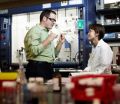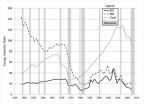(Press-News.org) DURHAM, N.C. -- Humans are known to play it safe in a situation when they aren't sure of the odds, or don't have confidence in their judgments. We don't like to choose the unknown.
And new evidence from a Duke University study is showing that chimpanzees and bonobos, our closest living primate relatives, treat the problem the same way we do.
In studies conducted at the Tchimpounga Chimpanzee Sanctuary in Republic of Congo and Lola ya Bonobo Sanctuary in Democratic Republic of Congo, researchers found the apes prefer to play it safe when the odds are uncertain.
Graduate student Alexandra Rosati and Brian Hare, an assistant professor of evolutionary anthropology, asked 16 chimps and 14 bonobos to make choices between two bowls of treats.
Though no dice or chips are involved, this kind of experiment is considered a "gambling game," Rosati said. The apes could choose between a safe bet that would always provide a food they liked somewhat less, peanuts, or a variable bet in which the payout could be either a highly-preferred big piece of banana or less-desirable cucumber slice.
The apes "gambled" by making a choice of one bowl or the other. They knew the odds before they chose because the experimenter showed them bowls with two potential outcomes, but then gave them only one. Depending on the contents of the bowls, there could be a 100 percent chance of receiving a banana, a 50 percent chance, or a 0 percent chance.
The apes readily distinguished between the different probabilities of winning: they gambled a lot when there was a 100 percent chance, less when there was a 50 percent chance, and only rarely when there was no chance.
In some trials, however, the experimenter didn't remove a lid from the bowl, so the apes couldn't assess the likelihood of winning a banana.
The odds from the covered bowl were identical to those from the risky option: a 50 percent chance of getting the much sought-after banana. But apes of both species were less likely to choose this ambiguous option.
They were willing to take the chance on the covered bowl when they knew the only alternative was food they didn't like (the cucumber), or no food at all. But, like humans, they showed "ambiguity aversion" -- preferring to gamble more when they knew the odds than when they didn't.
Given some of the other differences between chimps and bonobos, Hare and Rosati had expected to find the bonobos to be more averse to ambiguity, but that didn't turn out to be the case.
Researchers looking for the foundations of economic decision-making have been doing studies like this on a variety of species, but these two apes are the two species most closely related to humans, Rosati said.
"These results suggest that understanding how animals forage may be more complex than previously thought," Rosati said.
Decision-making matters to animals in the wild who have to make choices about which resources to pursue on the fly, without knowing if their choices will pay off. "It may be that different decision mechanisms come into play when animals are faced with choices when they have incomplete knowledge," Rosati said.
"These results also suggest that some of our human economic biases may be evolutionarily ancient, predating modern markets: chimpanzees and bonobos act just like us when faced with a primate slot machine," Rosati said.
###
CITATION:
"Chimpanzees and bonobos distinguish between risk and ambiguity," Alexandra Rosati & Brian Hare. Biology Letters, November 2010. doi:10.1098/rsbl.2010.0927
END
A national conversation continues about the best ways to improve both the quality of medical care and to contain costs. So far, developing quality measurements has focused on primary care or highly prevalent, chronic conditions such as asthma and diabetes. But what about brain disorders? To date, the number of measures that apply to neurologic care has been limited.
The American Academy of Neurology (AAN), an association of more than 22,500 neurologists and neuroscience professionals, reached out to a group of neurologists to develop such a set of measurements. Led ...
If fossil fuels burn completely, the end products are carbon dioxide and water. Today the carbon dioxide is a waste product, one that goes into the air — adding to global warming; or the oceans — acidifying them; or underground — with as yet unknown consequences.
But it's not impossible, says Liviu M. Mirica, PhD, assistant professor of chemistry at Washington University in St. Louis, to drive things the other way, turning carbon dioxide into fuels such as methanol or hydrocarbons.
Until now reversing combustion has been a loser's game, because making carbon dioxide ...
An overlooked cause of the economic recession in the U.S. is a decade long decline in the quality of the nation's energy supply, often measured as the amount of energy we get out for a given energy input, says energy expert Carey King of The University of Texas at Austin.
Many economists have pointed to a bursting real estate bubble as the initial trigger for the current recession, which in turn caused global investments in U.S. real estate to turn sour and drag down the global economy. King suggests the real estate bubble burst because individuals were forced to pay ...
DALLAS, Nov. 29, 2010 — Women with a history of migraine headache with aura (transient neurological symptoms, mostly visual impairments) are at increased risk of stroke. However, according to new research reported in Circulation: Journal of the American Heart Association stroke events in women with migraine with aura are more likely to have mild or no disability compared to those without migraine.
In a new analysis of the Women's Health Study involving 27,852 women over 13.5 years, researchers found those who have migraine with aura and who experience an ischemic stroke ...
TEMPE, Ariz. – Glass is something we all know about. It's what we sip our drinks from, what we look out of to see what the weather is like before going outside and it is the backbone to our high speed communications infrastructure (optical fibers).
But what most people don't know is that "glass transitions," where changes in structure of a substance accompanying temperature change get "frozen in," can show up during cooling of most any material, liquids through metals. This produces "glassy states," of that material – exotic states that can be unfrozen and refrozen by ...
New Haven, Conn.—The risk of dying from a heat wave is highest when heat waves occur early in the summer and are hotter and longer than usual, according to a Yale study published in the journal Environmental Health Perspectives (EHP).
During the first heat wave of a summer, the risk of mortality increases 5.04 percent, compared to 2.65 percent for heat waves that occur later in the summer. Michelle Bell, a co-author of the study and associate professor of environmental health at the Yale School of Forestry & Environmental Studies, said that people may be less accustomed ...
In a new UCSF study of more than 2 million mammogram screenings performed on nearly 700,000 women in the United States, scientists for the first time show a direct link between reduced hormone therapy and declines in ductal carcinoma in situ (DCIS) as well as invasive breast cancer. The researchers saw such a striking decrease, they believe they also have uncovered indirect evidence that hormones promote breast tumor growth.
The declines occurred in the age groups that most widely embraced then abandoned hormone therapy.
For nearly a decade, postmenopausal women have ...
La Jolla, CA – November 29, 2010 - For Immediate Release – A team of scientists from The Scripps Research Institute have uncovered a previously unknown regulatory mechanism in the body's response to eliminate pathogens, such as bacteria and viruses. The findings challenge a long-held dogma in the field of immunology and have potential implications for far-ranging topics from how vaccines should be administered to the origin of autoimmunity.
The results of the study, led by Scripps Research Professor Michael McHeyzer-Williams, were published in the December issue of the ...
Vitamin D and calcium have been the focus of much research since the Institute of Medicine set nutritional reference values for them in 1997. Known as Dietary Reference Intakes, the values for these and other nutrients serve as a guide for good nutrition and provide the scientific basis for the development of food guidelines in both the United States and Canada. Updated DRIs for these two nutrients are presented in a new IOM report, Dietary Reference Intakes for Calcium and Vitamin D, which will be released on Tuesday, Nov. 30.
INFORMATION:
Details:
Embargoed copies ...
CHICAGO – People with obstructive sleep apnea (OSA), a sleep disorder associated with obesity, have more non-calcified or "bad" plaque in their coronary arteries, according to a study presented today at the annual meeting of the Radiological Society of North America (RSNA).
"Our study reveals that individuals with obstructive sleep apnea are prone to developing an aggressive form of atherosclerosis that puts them at risk for impaired blood flow and cardiovascular events," said U. Joseph Schoepf, M.D., professor of radiology and medicine and director of cardiovascular ...

